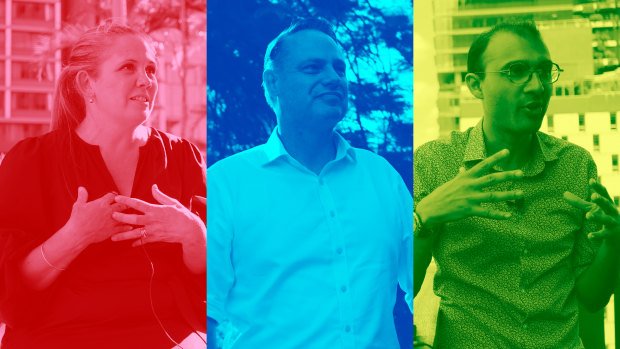This was published 1 year ago
What 20 identical questions revealed about Brisbane’s would-be lord mayors
The importance of keeping rates low has emerged as the most glaring difference between the three main candidates for Brisbane lord mayor, after each answered identical questions about their candidacies, their lives and their influences.
Brisbane Times prepared 20 questions that were designed to be as neutral as possible, while still allowing candidates leeway to communicate their governing priorities and, hopefully, give voters an idea of their personalities.

Brisbane lord mayoral candidates Tracey Price (Labor), Adrian Schrinner (LNP) and Jonathan Sriranganathan (Greens).Credit: Matt Dennien/Jocelyn Garcia
The first interview was Greens candidate Jonathan Sriranganathan, who met us on a rooftop overlooking King George Square last Thursday morning.
That afternoon, we met Labor candidate Tracey Price in a small park across the road on Albert Street, within earshot of City Hall’s famous bells.
And, on Friday afternoon, we met Lord Mayor Adrian Schrinner in Woolcock Park, Red Hill, when he was between LNP election campaign commitments.
The 20 questions Brisbane Times posed to our lord mayoral candidates
- Why are you running?
- Who is your political role model, and why?
- And your biggest role model outside of politics?
- Sum up your philosophy to governing in three words.
- What was the moment you decided to pursue a political career?
- What do you see as the three biggest issues facing Brisbane and what plans do you have to deal with them?
- On population growth, how big is too big for Brisbane?
- What’s more important to you - service delivery, or keeping rates low?
- Is Brisbane City Council well served by the party political system?
- What has been the most enjoyable thing about your campaign so far?
- And the least?
- If elected lord mayor, could you work with councillors from other parties – or independents – if your party does not get a majority in City Hall?
- How would your administration leverage the Olympics?
- What’s the biggest mistake you’ve made, and what did you learn from it?
- How do you commute to work?
- What’s the best concert, artistic or sporting event you’ve been to?
- What is your favourite meal?
- What three words best describe you?
- Do you have political ambitions beyond City Hall?
- What positive things can you say about your main two rivals?
The three other candidates, Clive Brazier from the Legalise Cannabis Party and independents Bruce Tanti and Gilbert Holmes, were not invited to take part.
The reason for this is simple – none of them were considered to have a realistic chance of becoming lord mayor.
Brazier’s policy platform is outlined on the Legalise Cannabis Queensland website and Tanti has created a campaign Facebook page outlining his policies.
Holmes has no online campaign presence, nor has he publicised their policy platforms.
The 20-question format was a departure from a normal journalistic interviewing technique, which would allow for follow-up questions and further interrogation.
What it revealed was three candidates with similar opinions about what challenges Brisbane faced – just different approaches in how to deal with those issues.
When asked what they considered to be Brisbane’s three biggest challenges, transport and traffic emerged as common themes.
In that regard, Labor and the Greens were very much focused on public transport.
“The Greens want to create more dedicated high-frequency bus services that run directly between suburbs, because not everyone wants to go all the way into the city,” Sriranganathan said.
Price had a similar observation.
“Everything is very central-focused, city-centre-focused, and I think that we need to create a public transport system that actually goes around our city as well and also connects local communities to local shops and increased frequency,” she said.
The LNP, meanwhile, had more of a focus on road upgrades as a way to make motorists’ lives easier.
“We’ve got a four-point plan on congestion, which involves upgrading roads, delivering better public transport and moving from public transport to mass transit, through projects like the metro,” Schrinner said.
“Also, active travel infrastructure with new bridges and bikeways, river walks, making it easy to walk, cycle and scoot around the city.
As for the other two challenges, Schrinner nominated the cost of living and housing.
Price nominated flood-smart development and infrastructure, and instilling a sense of community among Brisbane residents.
Sriranganathan, meanwhile, nominated housing and sustainable development
When asked what was more important, service delivery or keeping rates low, Labor and the Greens sung from similar hymn sheets.
Labor’s Price said: “If people see their value for their money, then rates don’t become so much of an issue.”
And Sriranganathan said it was a “false dichotomy” to make it an either/or proposition.
“We want to even that balance, put downward pressure on rates for residents and start ensuring that property developers and big business pay their fair share,” he said.
For Lord Mayor Adrian Schrinner, running for reelection under the LNP banner, it was a different story altogether.
The cost of living pressures felt by Brisbane residents, he said, were paramount in his thinking.
“In this current climate, [the priority] has got to be keeping rates low,” Schrinner said.
Brevity was encouraged for all candidates, but some took heed more than others.
Sriranganathan was by far most talkative, taking 21 minutes and 32 seconds to answer the 20 questions. Price took 13 minutes and 36 seconds, while Schrinner took 10 minutes and 33 seconds.
It should be noted, though, that both Sriranganathan and Price had to pause to allow the City Hall bells to chime.